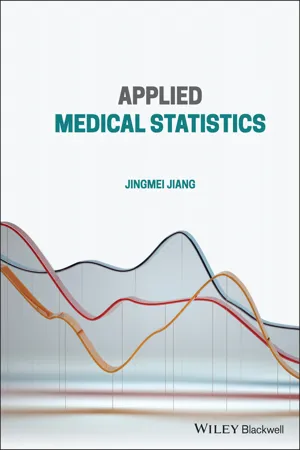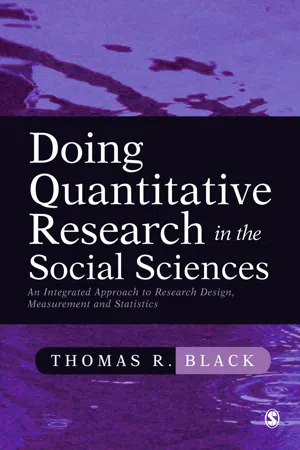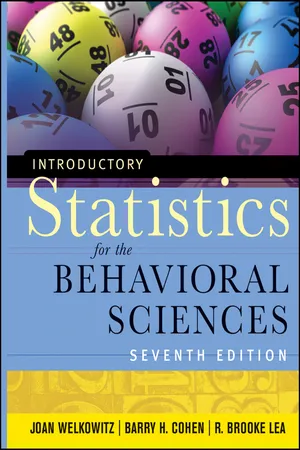Technology & Engineering
One Way ANOVA
One Way ANOVA, or analysis of variance, is a statistical method used to compare the means of three or more groups to determine if there are statistically significant differences between them. It assesses whether the variability within groups is similar to the variability between groups. This technique is commonly used in experimental research to analyze the impact of different factors on a dependent variable.
Written by Perlego with AI-assistance
Related key terms
Related key terms
1 of 4
Related key terms
1 of 3
11 Key excerpts on "One Way ANOVA"
- eBook - ePub
- David L. Johnson(Author)
- 2016(Publication Date)
- Wiley(Publisher)
Chapter 6 One-Way Analysis of VarianceObjectives
At the end of this chapter you should be able to:- Describe the underlying principle of the analysis of variance (ANOVA) technique
- Verify ANOVA's underlying assumptions
- Discuss the meaning of main and interaction effects in ANOVA
- Conduct parametric and nonparametric one-way ANOVA and interpret the results
- Select an appropriate post hoc pairwise comparisons strategy and perform the associated test calculations
6.1 Introduction
Parametric and nonparametric techniques for comparing a measurement to a known value or for comparing two measurements to each other were presented in Chapter 4 . In this chapter, we extend the discussion to comparison of more than two samples using the techniques of one-way ANOVA (also termed single-factor ANOVA and single-factor between-subjects ANOVA) and associated post hoc pairwise comparisons.6.2 Parametric One-Way ANOVA
The expected variation in measurements has been discussed in some detail in previous chapters. We expect that replicate measures of an unchanging quantity will not give exactly the same results, but will vary about some central value that is an estimate of the true value. In comparing two sample means, the two-sample -test determined whether the difference in the means appeared to be different from 0. However, in many situations, we are interested in comparing more than two means.Consider a situation in which we would like to compare the breakthrough times1 of several different types of protective gloves when challenged with a particular chemical. The independent variable – glove brand – has several “levels” or “treatments” (Brand A, Brand B, etc.). Given sample results with multiple replicate measures of chemical breakthrough time for each glove brand, a naive approach to determine whether any one mean breakthrough time is different from any other would be to simply perform two-sample -tests with all possible pairwise combinations of the glove brands. For three treatments, we would need three comparisons (A–B, A–C, B–C), but four treatments would require six (A–B, A–C, A–D, B–C, B–D, C–D), five would require ten, and so on.2 Each time we do such a test there is a probability of incurring a Type I (false positive) error, so that the cumulative probability of making a Type I error would be , where is the number of tests.3 - eBook - ePub
- Jingmei Jiang(Author)
- 2022(Publication Date)
- Wiley(Publisher)
9 One-way Analysis of VarianceCONTENTS- 9.1 Overview
- 9.1.1 Concept of ANOVA
- 9.1.2 Data Layout and Modeling Assumption
- 9.2 Procedures of ANOVA
- 9.3 Multiple Comparisons of Means
- 9.3.1 Tukey’s Test
- 9.3.2 Dunnett’s Test
- 9.3.3 Least Significant Difference (LSD) Test
- 9.4 Checking ANOVA Assumptions
- 9.4.1 Check for Normality
- 9.4.2 Test for Homogeneity of Variances
- 9.4.2.1 Bartlett’s Test
- 9.4.2.2 Levene’s Test
- 9.5 Data Transformations
- 9.6 Summary
- 9.7 Exercises
In Chapter 7 , we introduced the concept and methods of hypothesis testing and one-sample testing. Chapter 8 extended the ability to make statistical inferences from two sample situations. In this chapter, we introduce the use of analysis of variance (ANOVA) for hypothesis testing of more than two sample means with normal distributions. ANOVA was first introduced by the statistician R.A. Fisher in 1921 and is now widely applied in the biomedical and other research fields. ANOVA is a family of hypothesis testing methods for dealing with data obtained from different experimental designs. The basic principles of ANOVA methods are similar despite using different calculation ways with different designs. We focus on one-way ANOVA in this chapter and continue discussing ANOVA in different experimental designs in the next chapter. Further discussion of experimental designs can be found in Chapter 20 .9.1 Overview
One-way ANOVA refers to the analysis of variance for a completely randomized design under which all subjects are mutually independent. The experimental subjects are randomly assigned to k - eBook - ePub
- Jim Fowler, Lou Cohen, Philip Jarvis(Authors)
- 2013(Publication Date)
- Wiley(Publisher)
Analysis of variance (ANOVA) overcomes these difficulties by allowing comparisons to be made between any number of sample means, all in a single test. When it is used in this way to compare the means of several samples statisticians speak of a one-way ANOVA.ANOVA is such a flexible technique that it may also be used to compare more than one set of means. Referring to our island races again, it is possible to compare at the same time the mean lengths of samples of males and females of each race obtained from the islands. When the influence of two variables upon a sample mean is being analysed, such as island of origin and sex in our hypothetical example, the technique involved is described as a two-way ANOVA. Three-way, four-way (and so on) treatments are also possible but they get progressively more complicated. We restrict our examples in this text to one-way and two-way treatments.17.2 How ANOVA works
How analysis of variance is used to investigate differences between means is illustrated in the following example.Example 17.1
Compare the individual variances of the three samples below with the overall variance when all 15 observations n = 15 are aggregated.The means of Samples 1 and 2 are similar; the mean of Sample 3 is much lower; the mean of the aggregated observations is intermediate in value. The variances of the three samples are identical (10.00) and therefore the ‘average variance’ is 10.00. The variance of the aggregated observations however is larger (16.0) than the average sample variance. The increase is due to the difference between the means of the samples, in particular, the difference between the mean of Sample 3 and the other two means. The samples thus give rise to two sources of variability:(i) the variability around each mean within a sample (random scatter);(ii) the variability between the samples due to differences between the means of the populations from which the samples are drawn.In other words:ANOVA involves the dividing up or partitioning the total variability of a number of samples into its components. If the samples are drawn from normally distributed populations with equal means and variances, the within variance is the same as the between variance. If a statistical test shows that this is not the case, then the samples have been drawn from populations with different means and/or variances. If it is assumed that the variances are equal (and this is an underlying assumption in ANOVA) then it is concluded that the discrepancy is due to differences between means. - eBook - ePub
Social and Behavioral Statistics
A User-Friendly Approach
- Steven P. Schacht(Author)
- 2018(Publication Date)
- Routledge(Publisher)
11One-Way Analysis of Variance (ANOVA)
Chapter 9 explored various techniques of hypothesis testing where two group means were compared to determine whether there was a significant difference between them. This chapter explores situations where three or more group means are compared. The specific statistical technique to accomplish this is called Analysis of Variance , hereafter referred to as ANOVA (the actual ANOVA procedure is also referred to as an F test).More specifically, this chapter first outlines some of the advantages and theoretical assumptions that explain why ANOVA is often utilized as a statistical technique. It then presents an eighteen-step procedure for completing an ANOVA. When statistical significance is determined using ANOVA, subsequent statistical tests are often undertaken. One of these tests, called an LSD t-test , is also explored in terms of its calculations and what it represents. The chapter ends with some simple examples of ANOVA summary tables and how to interpret them.Advantages and Theoretical Assumptions of ANOVA
Like many statistical tests, ANOVA originated from studies in agriculture. Researchers in the agricultural sciences often study things such as the effects of different levels of irrigation on land plots with varied levels and types of fertilizers. In investigations such as this, the researcher is often faced with situations where dozens of group means must be compared. This translates into literally hundreds of potential t -tests; anything more than eleven groups correspondingly results in a minimum of 100 possible t -tests.To determine the number of possible t -tests that can be performed for 7 group means, simply plug 7 into a formula to find that there are 21 possible t -tests. These calculations are found below with the actual formula (J - eBook - ePub
Doing Quantitative Research in the Social Sciences
An Integrated Approach to Research Design, Measurement and Statistics
- Thomas R Black(Author)
- 1999(Publication Date)
- SAGE Publications Ltd(Publisher)
16 One-Way Analysis of VarianceSo far we have encountered two types of statistical test: the first determining the likelihood of one sample belonging to a population; and the second considering the probability of two samples belonging to a common population. To extend our testing capability to situations where there are three or more samples demands a new test. This one will require a slightly different approach in order to determine the likelihood that all the samples share a common trait. The approach will compare the sample means for the measured characteristic indirectly using estimates of population variances instead, which is why it is referred to as analysis of variance (ANOVA).In this chapter, we will consider studies that wish to compare three or more groups, traits, or treatments that are variations of a variable, such as educational background (ex post facto) or types of counselling received (experimental). In the next chapter, two-dimensional studies will be considered, where the interaction of traits or treatments would be of interest. For example, if investigating the influence of gender and educational background on income at age 40, one would want to know if combinations of gender and each of three types of education made a difference (a 2 × 3 design). A design considering three different counselling techniques for those addicted to heroin may wish to compare the consequences of the approaches for subjects in clinics, in hostels, and day clients (a 3 × 3 design). In Chapter 18 - eBook - ePub
Introductory Probability and Statistics
Applications for Forestry and Natural Sciences (Revised Edition)
- Robert Kozak, Antal Kozak, Christina Staudhammer, Susan Watts(Authors)
- 2019(Publication Date)
- CAB International(Publisher)
12 Analysis of VarianceTesting Differences between Several MeansSeveral procedures for comparing two unknown population means were presented in Chapter 9 . In many practical problems, however, we may be interested in comparing more than two population means. For instance, to study the effects of three different fertilizers on the height growth of Douglas-fir seedlings, a forest practitioner would need to test a hypothesis involving three population means. Similarly, to investigate the effects of these three fertilizers on the water quality in nearby creeks, a hydrologist would also need to compare three population means. In this chapter, we introduce a technique called analysis of variance , which enables us to compare the equality of two or more population means.Analysis of variance, often referred to by the acronym ANOVA, is one of the most powerful and frequently used techniques in statistics. It is used to analyse data obtained through both experimental designs and sampling designs , some of which will be introduced in Chapter 13 .We offer two definitions of analysis of variance:1. A statistical tool that compares two or more unknown population means.2. A method for partitioning the total variation of the data into meaningful components, and comparing these different sources of variation.In regression analysis (see Chapter 11 ), we saw two examples of partitioning varia tion. First, we partitioned the total sum of squares of the dependent variable (SST) into sum of squares due to regression (SSReg) and sum of squares residual (SSRes). Second, we partitioned the sum of squares residual into sum of squares pure error (SSPe) and sum of squares due to lack of fit (SSLf - eBook - ePub
Statistics for Machine Learning
Implement Statistical methods used in Machine Learning using Python (English Edition)
- Himanshu Singh(Author)
- 2021(Publication Date)
- BPB Publications(Publisher)
Figure 7.1: Samples having the same means vs. samples having different meansOne-way ANOVA test
In the career choice example in the previous section, we made a comparison using a single factor salary . When we use a single factor for the comparison of three or more means, the test is termed as 1-factor ANOVA or one-way ANOVA test. In this section, we’ll look at this test in further detail.When we talk about one-way ANOVA tests, a few assumptions that need to be followed are:- The sample chosen for the test should be completely random, with no bias. This design of an experiment is called randomized design.
- The response variable should be quantitative only. As we have seen in the previous example, the response variable was salary.
- The different domains we choose for the analysis are called the levels of treatment, and they should be three or more.
- The variance of the population must be similar.
- All the subjects in each group (levels) must be independent of each other.
- The population must be normally distributed.
One thing to consider while designing the experiment is that all the subjects must have similar characteristics. For instance, in the salary example, we had three career choices, but the people selected in the category of each career choice should have similar characteristics. They can be similar in age, the country in which they are living, the type of education they have completed, and so on. Once this sort of experiment is designed, we can successfully execute one-Way ANOVA over it.As discussed earlier, we can use the ANOVA test to determine whether the means of the levels of treatment are different. However, it doesn’t tell which mean is greater or smaller than the other. This can be done using the Tukey test - eBook - ePub
- Debbie L. Hahs-Vaughn, Richard G. Lomax(Authors)
- 2020(Publication Date)
- Routledge(Publisher)
1One-Factor Analysis of Variance—Fixed-Effects ModelChapter Outline
1.1 What One-Factor ANOVA Is and How It Works 1.1.1 Characteristics 1.1.2 Power 1.1.3 Effect Size 1.1.4 Assumptions 1.2 Computing Parametric and Nonparametric Models Using SPSS 1.2.1 One-Way Analysis of Variance 1.2.2 Nonparametric Procedures 1.3 Computing Parametric and Nonparametric Models Using R 1.3.1 Introduction to R 1.3.2 Reading Data Into R 1.3.3 Generating the One-Way ANOVA Model 1.3.4 Generating the Welch Test 1.3.5 Generating the Kruskal-Wallis Test 1.4 Data Screening 1.4.1 Normality 1.4.2 Independence 1.4.3 Homogeneity of Variance 1.5 Power Using G*Power 1.5.1 Post Hoc Power for the One-Way ANOVA Using G*Power1.6 Research Question Template and Example Write-Up 1.7 Additional Resources1.5.2 A Priori Power for the One-Way ANOVA Using G*PowerKey Concepts
- Between- and within-groups variability
- Sources of variation
- Partitioning the sums of squares
- 4. The ANOVA model
- 5. Expected mean squares
The first six chapters of this text are concerned with different analysis of variance (ANOVA) models. In this chapter, we consider the most basic ANOVA model, known as the one-factor analysis of variance model. Recall the independent t test where the means from two independent samples were compared. What if you wish to compare more than two means? The answer is to use the analysis of variance - Christophe Lalanne, Mounir Mesbah(Authors)
- 2016(Publication Date)
- ISTE Press - Elsevier(Publisher)
4Analysis of Variance and Experimental Design
Abstract:
In this chapter, we will address analysis of variance and a few elementary notions about the design of experiments. Only the ANOVA cases with one and two classification factors (fixed effects, interaction model) are discussed. For a single-factor ANOVA, the linear tendency test is approached using two techniques: linear regression and the contrast method. The case of multiple comparisons between treatments is also discussed, considering only the Bonferroni method to protect the inflation of the Type I error risk. It remains, however, important to achieve an in-depth data description in all cases prior to performing the ANOVA model (numerical summaries, graphics methods, etc.).Keywords
ANOVA; Data representation; Data representation format; Data structuring; Descriptive statistics; Diagnostic model; Linear trend test; Non-parametric one-way ANOVA; Two-way ANOVAIn this chapter, we will address analysis of variance and a few elementary notions about the design of experiments. Only the ANOVA cases with one and two classification factors (fixed effects, interaction model) are discussed. For a single-factor ANOVA, the linear tendency test is approached using two techniques: linear regression and the contrast method. The case of multiple comparisons between treatments is also discussed, considering only the Bonferroni method to protect the inflation of the Type I error risk. It remains, however, important to achieve an in-depth data description in all cases prior to performing the ANOVA model (numerical summaries, graphics methods, etc.).- eBook - ePub
- Bruce J. Chalmer(Author)
- 2020(Publication Date)
- CRC Press(Publisher)
Chapter 14 .The null hypothesis tested in a one-way ANOVA is that the means of several populations are equal. The alternative hypothesis is that at least one mean differs from the others. Note that the one-way ANOVA is inherently a two-tailed test, in the sense that we are looking for any type of difference, in any direction, among the population means.If we have only two populations of interest, the one-way ANOVA is equivalent to the two-sample t test. In fact, when we have only two samples the F statistic used in the one-way ANOVA (discussed below) is simply the square of the t score from the two-sample t test. This suggests that the assumptions for the one-way ANOVA had better be the same as those for the two-sample t test—and indeed they are.Assumptions required for one-way ANOVA
Just as for the two-sample t test, three assumptions are required for one-way ANOVA. First, we require that all individual scores be independent of one another, both within and among samples. Second, we require that all populations have normal distributions. Third, we require that all populations have the same standard deviation (homogeneity).Assumptions should be checked by looking at pictures of the sample histograms, by inspecting the sample standard deviations, and when in doubt, by applying one of the fancier techniques described briefly in Appendix C. Violations of the normality or homogeneity assumptions can sometimes be made less severe by transforming the data, using one of the methods described in Appendix C.Sums of squares
Before we get into it, note that this discussion is directed toward understanding rather than computational detail. Nowadays, we almost always use a packaged computer program to carry out the calculations, right down to the test statistic. - Joan Welkowitz, Barry H. Cohen, R. Brooke Lea(Authors)
- 2012(Publication Date)
- Wiley(Publisher)
Part III Analysis Of Variance MethodsChapter 12 One-Way Analysis of Variance Chapter 13 Multiple Comparisons Chapter 14 Introduction to Factorial Design: Two-Way Analysis of Variance Chapter 15 Repeated-Measures ANOVAPassage contains an image Chapter 12 One-Way Analysis of Variance Preview Introduction
We wish to draw inferences about the differences among more than two population means. Why is it a poor idea to perform numerous t tests between the various pairs of means?What is the experimentwise error rate?In what way is one-way analysis of variance similar to the t test for the difference between two means? How does it differ?The General Logic of ANOVA If we wish to draw inferences about population means; why are we analyzing variances? What is the within-group (or error) variance estimate? What is the between-group variance estimate?What is the F ratio?Computational Procedures What are the procedures for drawing inferences about any number of population means by computing a one-way analysis of variance? What are sums of squares? Mean squares?Testing the F Ratio for Statistical SignificanceWhat is the correct statistical model to use for testing an ANOVA?How do we test the F ratio for statistical significance?Calculating the One-Way ANOVA From Means and Standard DeviationsHow can you calculate the F ratio for an ANOVA if you do not have the raw data but only a table of means, standard deviations, and sample sizes? Why might you need to do this?Comparing the One-Way ANOVA With the t TestWhat is the relationship between the t value and the F
Index pages curate the most relevant extracts from our library of academic textbooks. They’ve been created using an in-house natural language model (NLM), each adding context and meaning to key research topics.
Explore more topic indexes
Explore more topic indexes
1 of 6
Explore more topic indexes
1 of 4










